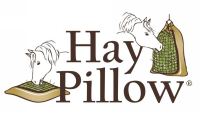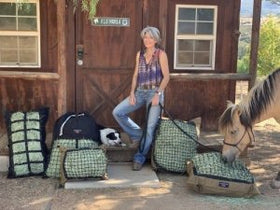Fly Spray: 3 Ingredients You Need to Know About
Read on to learn more about how fly spray enters the bloodstream, three common ingredients that may not be safe and some suggested - and safer - options.

It’s safe to say that fly sprays are most commonly used during warmer weather thereby increasing the ability to enter the bloodstream.
You and your horse’s normal cooling system works by first dilating (make or become wider, larger, or more open) blood vessels on the skin’s surface to allow more warm blood to flow near the surface of the skin where the heat can be lost to the air.
When blood vessels expand (dilate), pores open in the skin that lead to sweat glands increasing the surface area for dermal penetration. Perspiration then moves onto the skin; heat transfers from the body to the sweat and eventually cools the skin. The average person has 2.6 million sweat glands in their skin and can only imagine the number of sweat glands in a horse!
Note: the horse’s hair coat does not provide foolproof protection from fly spray coming into direct contact with the skin.
If fly spray is inhaled, it enters the bloodstream via the vast vascular blood supply to the lungs.
3 Common Insecticidal Fly Spray Ingredients
1. Pyrethrins (natural) are botanical insecticides derived from chrysanthemum flowers most commonly found in Australia and Africa. They work by altering nerve function, which causes paralysis in target insect pests, eventually resulting in death.
2. Permethrin (included in the class of Pyrethroids) is a synthetic chemical insecticide whose chemical structure is adapted from the chemical structures of pyrethrins and act in a similar manner by altering nerve function, which causes paralysis in target insect pests, eventually resulting in death. Pyrethroids are modified to increase their stability in sunlight. There are more than 1,000 different pyrethroids in use today, though less than a dozen are available in the United States. Permethrin being the most common used in fly spray.
3. Piperonyl butoxide (PBO) is often included in topical insecticide formulations to enhance insecticidal activity. It is the most common synergist used in conjunction with Pyrethrin and Permethrin.
Both Pyrethrin and Pyrethroids are highly toxic to fish and moderately toxic to birds and bees. They - along with Piperonyl butoxide (PBO) - are classified as Restricted Use Pesticides (RUP) by the Environmental Protection Agency (EPA), which means that their use in products is restricted to certified manufacturers.
Safety / Side Effects of Pyrethrins & Permethrin
The safety / side effects listed below are for humans. Despite exhaustive efforts, I could find no information/studies on short or long term effects on horses.
- Inhalation: coughing, wheezing, shortness of breath, runny or stuffy nose, chest pain, or difficulty breathing.
- Skin contact: rash, itching, or blisters.
- Long term effects: disrupts the endocrine system by mimicking the female hormone, estrogen, thus causing excessive estrogen levels in females. In human males, its estrogenizing (feminizing) effects include lowered sperm counts. In both, it can lead to the abnormal growth of breast tissue, leading to development of breasts in males and cancerous breast tissue in both male and females.
- Neurotoxic effects include: tremors, incoordination, elevated body temperature, increased aggressive behavior, and disruption of learning. Laboratory tests suggest that permethrin is more acutely toxic to children than to adults.
- A known carcinogen. There is evidence that pyrethroids harm the thyroid gland. Causes chromosomal damage in hamsters and mice; deformities in amphibians; blood abnormalities in birds.
- United States EPA Permethrin Fact: “In 1985 a Data Call-In (DCI) for ecological effects data for permethrin was issued. After evaluation of this data, EPA concluded that the current RUP classification be maintained for all products for wide area agricultural uses (except livestock and premises uses) and outdoor wide area non-crop uses because of the possible adverse effects on aquatic organisms from spray drift and runoff.”
Safety / Side Effects of Piperonyl Butoxide (PBO)
- Can cause eye, nose, respiratory and skin irritation.
- Acute exposure: Nausea, vomiting, abdominal cramps, diarrhea and a known carcinogen.
- A 2011 study, conducted at Columbia University and published in the journal Pediatrics, found that infants whose mothers had been exposed to low levels of piperonyl butoxide (PBO) during their third trimester showed delayed mental development by the age of three.
Safer Options
- Go herbal. My favorite fly spray is an herbal concentrate. I prefer the concentrate as it is by far the most economical. I mix a gallon at a time (stored in a cool shady place) and use a wide mouth spray bottle so I don’t have to use a funnel to fill it (shake the gallon well before filling).
- Make your own. If you’re a DIY'er, there are a multitude of homemade recipes online.
- Use fly masks and/or fly sheets when possible.
- Fly predators and fly traps can be effective to reduce the fly population.
- Manage manure: Horse manure is an attractive home for house flies, which mate and lay eggs in animal feces. In the summer, the fly life-cycle takes about two weeks: one week for larvae to develop and one week to pupate before emerging as new adults. Weekly removal and spreading of manure disrupts the fly life-cycle - preventing new adults from emerging.
- Diet: A balanced diet providing necessary vitamins and minerals optimizes the immune system decreasing the risk of contracting diseases from biting insects.
- Follow instructions: if using a concentrate or making your own, dilute accordingly.
In Closing
- Read all labels and research ingredients (Pyrethroids usually end in an "IN") before purchasing or using any fly spray.
- If it poses a health risk there must be a legal statement such as: Avoid contact with eyes, skin, clothing or inhalation.
- Don't assume that all natural ingredients are safe.
Helpful How to Resources for Slow Feeding
- Sand Colic - The Surprising (Simple) Cure & Prevention
- Feeding Miniature Horses & Donkeys: Why Slow Fed Forage is Best
- How to Introduce & Incorporate Free-Choice Forage: A Detailed Action Plan
- Can Horses Eat More Hay Without Weight Gain? The Surprising Factors
- A Safer Always Have Hay Source – Mature Grass Hay
- Slow Feed Solutions for Any Environment
- 6 Great Reasons to Feed Your Horse from Ground Level
- 9 Benefits of Slow Feeding Horses
- 7 Slow Feed Dos and Dont's for Horses
- 7 Easy Ways to Help Prevent Colic
- Preventing Equine Gastric Ulcers - How Forage Buffers Acid
- Equine Gastric Acid - 12 Facts You May Not Know
- Never Exercise Horses on an Empty Stomach...Ever
- Why You Shouldn't Transport Horses On An Empty Stomach
- Keeping Horses Warm Naturally – Internally and Externally
- Why Most Horse Prefer to Eat Outside
- Horse Boredom Busters - Toys & Enrichment Tips for Stall or Pasture
References:
- Tag: piperonyl butoxide, UPDATE: West Nile Virus vs. Pyrethroid Exposure, Retrieved from: https://wellnessandequality.com/tag/piperonyl-butoxide/
- PubChem Open Chemistry Database, Retrieved from: https://pubchem.ncbi.nlm.nih.gov/compound/5794#section=IUPAC-Name
- EPA Permethrin Facts, (Reregistration Eligibility Decision (RED) Fact Sheet), Retrieved from: https://www3.epa.gov/pesticides/chem_search/reg_actions/reregistration/fs_PC-109701_1-Jun-06.pdf
- Kaplan, Melissa, Pyrethroids: Not as safe as you think, Retrieved from: http://www.anapsid.org/pyrethroids.html
- Stouffer, Judy, Fly Control For Horses, Retrieved from: http://www.michaelandjudystouffer.com/judy/articles/horsefly.htm
- Quizlet, Science – Skin, Retrieved from: https://quizlet.com/118507251/science-skin-flash-cards/
- Furlong, Zoe, How Do Toxics Enter Our Bodies?, Retrieved from: https://www.ursamajorvt.com/blogs/the-blog-cabin/37974081-how-do-toxics-enter-our-bodies





2 Comments -
Linda • -
Eric DT •
Hi,
Thanks for the article!
You mentioned an herbal concentrate that you prefer and you mentioned that there are many DIY recipes on the Internet but you don’t provide any links or references to get us started… In the context of this is what you use, but we’ll have to make up our own minds and do our own research could you please provide the recipe you use and/or the webpage where you got your recipe? Or similar?
I think if you post it with all the disclaimers, it could be very helpful to me and other folks so we don’t have to start our own monster research experimentation project to figure out something someone else has already found is very effective.
Thanks,
Linda King
linda.m.king@outlook.com
Good evening. I read your article about the safety of fly sprays for horses. You also mentioned a natural / herbal option, but I did not see what that option exactly is. Could you please point me in the right direction? Very much appreciated. Eric